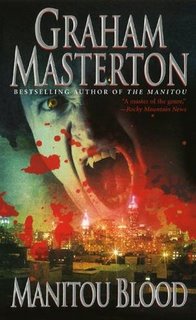 Author: Graham Masterton
Author: Graham Masterton
Release Date: 2005
Contains spoilers
Flush with my enjoyment of Descendant, I noticed this in a local bookstore. Couple of things to note, firstly whilst Manitou Blood is about strigoï, it is not the same type of vampire as we met in Descendant and the rules are somewhat different. Second thing to note is that this is (the latest) part of a series, with recurring characters from said series. That said it is designed to stand alone and, given that I have not read the others in the series, does that admirably.
The book begins with Doctor Frank Winter watching a street mime, a young woman, covered in silver body paint, with whom he is fascinated. At the end of her performance Frank approaches her but she begins to copiously vomit blood and he rushes her to his hospital. The tests are bizarre, she is hyper-sensitive to sunlight (only the body paint allowed her to go into the light it seems), she is anaemic and there is a strange element in her blood. Scans show no ulcer that could have caused the blood vomiting and when the test results come back they discover that it is two different blood-types, neither hers. We then discover that she felt as though she had been burning up, back in her apartment, and slit the throats of her flatmates as drinking their blood was the only thing that, she believed, could cool her.
Soon more and more cases are coming to light, each time the same and the doctors search for a new virus whilst the press talk about vampire killings. All the victims started with symptoms including hydrophobia and recurring dreams – all the same – of being locked in coffins whilst crossing the ocean. All the victims seem to chant the same strange phrase, “Tatal Nostru.”
Harry Erskine, one of the recurring characters, is a psychic conman who has been forced to accept the supernatural. He is approached by a young man who is having recurring dreams. Trying to contact his spirit guide, Singing Rock, Harry is shown the source of the young man’s nightmares a malevolent spirit that he only catches a fleeting glimpse of. It soon becomes clear, as he discovers about the disease, that it is no natural disease but a spiritual attack on the city. However, by then the vampires have reached plague proportions and all the infected soon die… at which point their bodies get up and continue to function. New York City is in chaos and the authorities have abandoned it, forming a perimeter quarantine. It is up to the odd-ball group of Harry, Gil (an ex-soldier), Frank (now infected himself) and Jenica (the daughter of a Romanian strigoï expert) to stop the infection before it spreads city to city.
The vampires are strigoï, but different to those in Descendant. The infected are controlled by a powerful dead vampire or svarcolaci. To stop the spread of the plague they have to find and bind that entity and, of course, find a way to stop those already turned. The book mixes things up well. The prose is a combination of third person and (when with Harry) first person, that works well. The myth sources mix Romanian vampire lore with Native American spirituality.
The recurring characters work well, despite having not met them before. Harry is fantastic, a real anti-hero rogue out to make a fast buck and then faced with the undeniable task of being honourable and saving the world.
In Descendant we had vicious vampires and these are similar, yet I don’t think their impact was as strong. The book has its fair share of gore and the infection is virulent and overruns a city, giving an apocalyptic feel that shared much with I Am Legend and yet there was a sadness to it. We see the infected with sympathy due to the focus on the anguish of one or two of them, and that lessens, to a degree, their impact. They are less the faceless beasts of the night – especially due to Frank who fights the infection – but poor, scared people forced to act in horrific ways by factors out wih their control. Don’t get me wrong, this is still more horror than many titles out there, just not as intense as Descendant.
If I had another issue with the novel, then that issue is within me rather than the book itself and it is the apocalyptic nature of the novel. I enjoyed Descendant more than this because it seemed more microcosmic. Manitou Blood shows the rapid destruction of a city on a macrocosmic scale. Perhaps if we had seen more of the plight of the ordinary citizens, holed up fearful as the vampires ruled the night... but the main human characters were extraordinary and whilst I appreciated them as characters I perhaps didn’t resonate with them completely. However, this is not a fault of the book, as I say, and it does not spoil the novel. It is, however, not exactly what I was searching for.
It is difficult to explain the lore Masterton uses in this without giving too much plot away but I will mention mirrors. We often see the image of smashed mirrors in vampire films, vampires smashing them for they have no reflection. In this the dead strigoï are able to pass through mirrors, using them as doorways. It is the humans who smash them.
This is a rip-roaring adventure horror with very much an occult/spiritualistic slant, not quite as good as the later book but still well worth your time and effort. 7.5 out of 10.
Monday, September 18, 2006
Manitou Blood – review
Posted by
Taliesin_ttlg
at
7:36 AM
![]()
Labels: plague, strigoï, svarcolaci, vampire
Subscribe to:
Post Comments (Atom)
















No comments:
Post a Comment